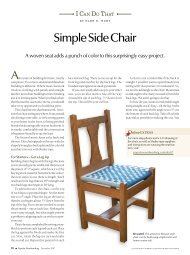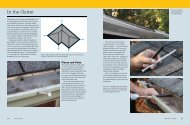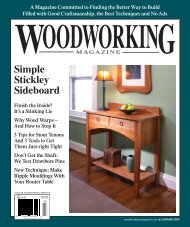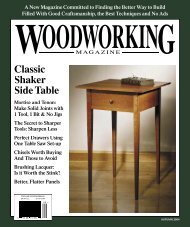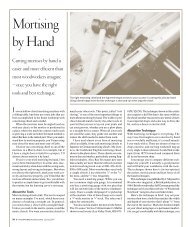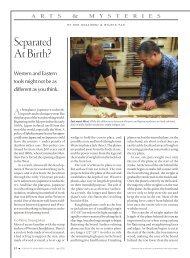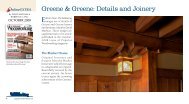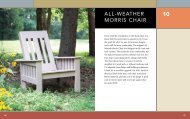Classic Shaker Side Table - Popular Woodworking Magazine
Classic Shaker Side Table - Popular Woodworking Magazine
Classic Shaker Side Table - Popular Woodworking Magazine
You also want an ePaper? Increase the reach of your titles
YUMPU automatically turns print PDFs into web optimized ePapers that Google loves.
The tenon length is determined by the diameterof the bit and its distance from the fence. Use aruler to get this setting close. Make a test cut andadjust the fit so it’s perfect.Your test set-up is perfect for milling the singleedge shoulder. Make this cut with the apron onedge guided by a back-up block or a miter gauge.After the second pass, your tenons should be onlya hair off. Make this cut on a piece of scrap first toensure you don’t overshoot your mark.then the other. Then glue those two assembliestogether. It takes more time, but there are fewerjoints to keep an eye on as the glue begins to setup. The glue-up procedure also reinforces thesometimes-fragile mortise wall created by thismortising technique.Be sure to do a dry fit. If the tenon won’t seat allthe way into its mortise, shorten your tenon untilit does. If there is a gap at the outside shoulder, tryparing away some of the end grain of the shoulderat the corner where it meets the cheek – but don’tchisel the edge of the shoulder that shows.During glue-up, add glue on the mortise wallsonly. Don’t glue on the shoulder and don’t worryabout gluing the edge cheeks or the mortise’s bottom.If you get glue there, that’s fine, but mostlyyou want to get the maximum amount of contactbetween the face cheeks and the mortise wall.ReinforcementsFinally, I think it’s a good idea to reinforce tabletenons using a wooden peg driven through theleg. But don’t peg your joints until the glue is setup. If you don’t want the peg to show, you can pegthe joint from inside the table base.No matter where you put the peg, the procedureis the same. Cut some pegs on your table saw;I like square stuff that’s a hair bigger than 1 ⁄ 4 " x1 ⁄ 4 ". I don’t use manufactured dowels because theyare inconsistent in size. Sharpen one end of yoursquare peg in a pencil sharpener and crosscut it to1" long. With a knife, trim off a good deal of thepointiest part of the end you sharpened.Take a drill with a 1 ⁄ 4 " brad-point bit and drillthe hole for the peg. The hole should be deepenough to pass all the way through the tenon butnot pass through the entire leg. Usually I like tocenter my pegs on the length of the tenon.Put a little glue in the hole and drive the peg inwith a hammer. As the peg hits bottom, the hammerwill make a different sound when it strikesthe peg. Stop hammering. Any more hits couldsplit the peg. As you’ll see, this procedure lets youput a square peg in a round hole. The corners ofthe peg bite into the surrounding wood to keep itfrom twisting out. Finally, trim the peg flush (oralmost flush) using a chisel, a gouge or a flushcuttingsaw, as shown below.With this simplified version of the mortiseand-tenonjoint mastered, you can see how a coupleof extra cuts can change it. Keep practicingthis joint and before you know it, that Arts &Crafts spindle bed or Morris chair will look likean easier (or at least doable) job. WM— Christopher SchwarzRoundedcorner leftby routerScrap guidesthe chiselThe best way to square the end of a mortise iswith a chisel that is the exact width of yourmortise. This joint will be concealed by thetenon shoulder, so it doesn’t have to be pretty.If you’ve never pegged a joint before, give it a try on one of your test joints. It’s actually simple andstraightforward work. This extra effort will add strength to your table base.10 ■ woodworking magazine Autumn 2004



